|
| |
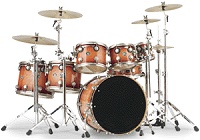 Drums
& Jazz Drummers Drums
& Jazz Drummers

Max Roach
In classical music, only two people
are important, the composer and the conductor. Everybody else is a serf.
But in jazz, a thing of beauty is created collectively with everybody getting to
express an idea. And that reflects what democratic society is --- or should be.
Set-up
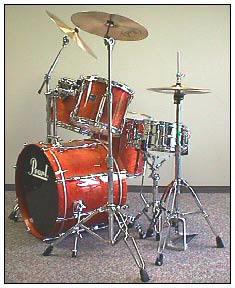 A
typical drum set consists of five drums: 14" snare drum, 22" bass drum, 16"
floor tom, and 12" and 13" rack toms (also called rack toms or toms). The
traditional method of describing drum sizes: depth followed by diameter. Thus, a
10"x12" tom is 10" deep and 12" in diameter; a 6 1/2"x14" snare drum is 6 1/2"
deep and 14" in diameter; and so on. Some companies, however, prefer to reverse
these dimensions. A
typical drum set consists of five drums: 14" snare drum, 22" bass drum, 16"
floor tom, and 12" and 13" rack toms (also called rack toms or toms). The
traditional method of describing drum sizes: depth followed by diameter. Thus, a
10"x12" tom is 10" deep and 12" in diameter; a 6 1/2"x14" snare drum is 6 1/2"
deep and 14" in diameter; and so on. Some companies, however, prefer to reverse
these dimensions.
The bass drum and floor tom need to be assembled. Locate the drum key and the
parts needed: shells, heads, rims and hoops, tension rods, and claws. Choose a
clean, open area to do the assembly and you're ready to go!
If
you don't already own a drum throne, purchase one. You'll be spending hours at
your set so select a throne that is sturdy and comfortable. Set the height of
the throne so that it carries most of your weight. This'll make you "light" on
your feet so you can play your pedals with maximum speed and agility. Position
the throne so you can reach the bass pedal comfortably.
Place the snare drum in front of you and adjust the height to a comfortable
level. You can play the snare drum tilted (as shown above) or flat. Experiment
with different tilt positions to discover which works best for you.
Position the hi-hat next to the snare drum within easy reach of your other foot.
Your legs should feel relaxed, not too close and not too far apart. Most of all,
you should feel balanced. Adjust the height of the hi-hat cymbals so that they
can be reached comfortably.
Adjust the height, tilt, and closeness of the 12" tom so that it butts up
against (but doesn't touch) the snare drum. Position the 13" tom beside the 12"
tom. Set the floor tom level to or slightly lower than the snare drum. Arrange
the toms compactly so that you can move from drum to drum quickly and easily.
When everything is comfortably positioned, tighten all Stop-Locks securely.
Position your cymbals where they can be reached easily and don't get in the way
of your drums.
Proper
Cymbal Playing Techniques
Give your
cymbals "breathing room." Bolting down the wing nut restricts the sound and can
cause damage to the cymbals. Replace worn plastic sleeves and felt washers on
the cymbal posts to prevent damage to your cymbals. Avoid extreme angles
when positioning your cymbals. Extreme angles not only restricts the movement
and diminishes the response of your cymbals, but also puts excess pressure on
the bell (cup) and can damage your cymbals. Avoid direct hits to the edge
of the cymbal - this may result in damage, especially to thinner cymbals. Strike
cymbals, especially splash, crash, and Chinese models, with quick glancing blows
to obtain optimum sound response while minimizing the possibility of damage.
Hi-hats should be loose and slightly tilted. This eliminates air lock and keeps
the sound crisp and consistent.
As
you learn more about your drums, you'll find that there is no right or wrong way
to do anything. What matters is what works best for you
Buddy Rich
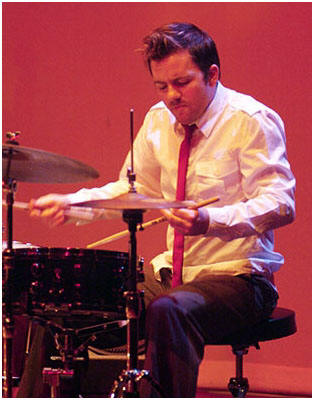 Alyn
Cosker Alyn
Cosker
Alyn Cosker has emerged as the top young drummer on
the Scottish jazz scene, handsomely fulfilling the promise he showed
as a teenager in the Strathclyde Youth Jazz Orchestra.
He has gone on to work in a variety of other contexts, from the
Tommy Smith Quartet and the Scottish National Jazz Orchestra to
Celtic-rock outfit Wolfstone.
His work as a composer is less familiar. ‘There are a lot of styles
going on within his trio, and he wanted to challenge himself’
The trio first came to notice in a sensational set at the Glasgow
Jazz Festival’s Homecoming concert last year, introducing electric
guitarist David Dunsmuir to a hitherto unsuspecting jazz audience,
the better-known Ross Hamilton completing the trio on bass.
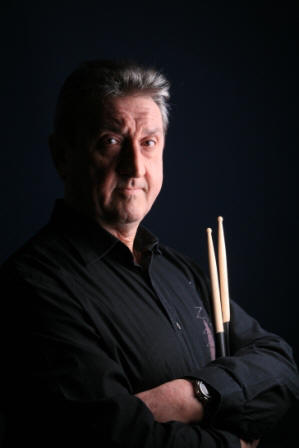 Dave
Barry Dave
Barry
Born in Cardiff. Moved to London late 60's and studied
percussion at the Royal Academy of Music [Pete Jacobsen and Stan Sulzmann
were also studying there at the same time. Joined Mike Westbrook in
1979; worked with his various ensembles and big band and toured Europe and
Australia. Was a member of the Tim Whitehead Quartet, with Pete Jacobsen and
Arnie Somoygi, for twelve years; has been a member of Don Weller's Quartet
and his big band for sixteen years and the John Critchenson -Art Themen
Quartet for ten years.
For the last five years he has been teaching drum kit
and percussion for the Borough of Croydon, and am now their Percussion
Coordinator. Also teaches at the Royal Ballet School, Richmond Park and
Shrewsbury House School in Surbiton
Bobby Orr
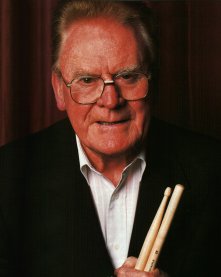  Bobby
Orr was born on 15 August 1928 in Cambuslang, Lanarkshire, Scotland..His
childhood was spent surrounded by, and immersed in, the rich drumming traditions
for which the Scots are world renowned. Bobby's father was a drum major, and it
was probably written in the stars that he would become a drummer The fact that
he began at the tender age of three gives you some idea of the talent we' are
dealing with here. Bobby
Orr was born on 15 August 1928 in Cambuslang, Lanarkshire, Scotland..His
childhood was spent surrounded by, and immersed in, the rich drumming traditions
for which the Scots are world renowned. Bobby's father was a drum major, and it
was probably written in the stars that he would become a drummer The fact that
he began at the tender age of three gives you some idea of the talent we' are
dealing with here.
- Art Blakey says, Hey man, you gonna
get up and play? I say no, but he grabs me by the scruff of the
neck, and I go up and play"
-
^ Swinging New York In 1956
Bobby regularly played at Ronnie
Scott's Club, backing top American jazz stars like Zoot Sims, Al Cohn, Milt
Jackson, and Dizzy Gillespie Bobby Orr is one of the true talents of
British drumming - a simple summing up for a man who has spent the best part of
70 years playing the instrument we love. His drumming credentials are exemplary
and to talk of the past is to see a drummer of an ilk and style that are all too
rare these days. But the thing that most impresses is the inspirational way
Bobby Orr still plays at 78 years old and recently appeared with Tommy McQuater
the veteran Scots trumpeter at Ealing Jazz Festival before his demise.
 Jazz Eddie - while erecting
posters for Gig 17 in Princes Risborough I was approached from behind by a curious
senior citizen - mmm Jazz Eh - have you heard of Bobby Orr the world famous
Jazz Drummer? the gentleman said - "I have as it happens" was
my terse and forward gazing reply - "Well that's me!" said Bobby - a
enthusiastic conversation then ensued about jazz and lapsed well into the
Scottish dialect. "Tell 'em I am still alive and drumming" he added.
Walters Ash is Rich beyond compare and Scotland is fair Scunnert. Bobby had a spell
as trumpeter with Basil Kirchin's band before giving up to concentrate on
Drums after embouchure problems. Bobby's Trio + Guests appear at a
fortnightly Sunday Jam Sessions at the Red Lion - Bradenham, Bucks. last of the
season on 31st July 6 - 9pm Jazz Eddie - while erecting
posters for Gig 17 in Princes Risborough I was approached from behind by a curious
senior citizen - mmm Jazz Eh - have you heard of Bobby Orr the world famous
Jazz Drummer? the gentleman said - "I have as it happens" was
my terse and forward gazing reply - "Well that's me!" said Bobby - a
enthusiastic conversation then ensued about jazz and lapsed well into the
Scottish dialect. "Tell 'em I am still alive and drumming" he added.
Walters Ash is Rich beyond compare and Scotland is fair Scunnert. Bobby had a spell
as trumpeter with Basil Kirchin's band before giving up to concentrate on
Drums after embouchure problems. Bobby's Trio + Guests appear at a
fortnightly Sunday Jam Sessions at the Red Lion - Bradenham, Bucks. last of the
season on 31st July 6 - 9pm
Bobby's Party Piece - Mozart -
Turkish March on an HB Pencil
http://www.youtube.com/watch?v=gnFW3uLTCA4
Bobby Orr is available for Drum
Tuition and Drum Clinics for all aspiring drummers in Bucks Berks or Oxon - there is no finer local
Tutor. If you wish to register your interest and gather like minded
students together he would be delighted to impart his insight and skills to all
such enthusiasts. - contact
Bobby Orr Drum Tuition
01494 566067
Tony
Royster Jr Drum Solo Video
Tony Royster Jr. is 25
years old now and plays like a seasoned professional drummer! Starting at the
age of 3, his prodigious talent helped him become proficient in the styles of
Jazz, Rock, Latin, and Funk at an early age. He has already had the opportunity
to share the stage with such notable drummers as Dennis Chambers, Steve Smith,
and Sheila E. and has won numerous drummer contests worldwide at events such as
The Montreal Drum Festival and Florida’s Drum Expo.
http://www.tonyroysterjr.com/
 Tony
Williams' death in 1997 of a heart attack after routine gall bladder surgery was
a major shock to the jazz world. Just 51, Williams (who could be a very loud
drummer) seemed so youthful, healthy, and ageless even though he had been a
major drummer for nearly 35 years. The open style that he created while with the
Miles Davis Quintet in the mid- to late '60s remains quite influential, and he
had a long list of accomplishments during the decades that followed. Williams'
father, a saxophonist, took his son out to clubs that gave him an opportunity to
sit in; at 11, the youngster already showed potential. He took lessons from Alan
Dawson, and at 15 was appearing at Boston-area jam sessions. During 1959-1960,
Williams often played with Sam Rivers, and in December 1962 (when he was barely
17), the drummer moved to New York and played regularly with Jackie McLean.
Within a few months he joined Miles Davis, where his ability to imply the beat
while playing quite freely influenced and inspired the other musicians; together
with Herbie Hancock and Ron Carter he was part of one of the great rhythm
sections. Williams, who was 18 when he appeared on Eric Dolphy's classic Out to
Lunch album, stayed with Davis into 1969, leading his own occasional sessions
and becoming a household name in the jazz world. In addition to his interest in
avant-garde jazz, Tony Williams was a fan of rock music, and when he left Miles
he formed the fusion band Lifetime, a trio with Larry Young and John McLaughlin.
After leading other versions of Lifetime (one of them starring Allan Holdsworth),
Williams stuck to freelancing for a time, studied composition, and toured with
Herbie Hancock's V.S.O.P. band. By the mid-'80s, he was heading his own all-star
hard bop group which featured Wallace Roney as a surrogate Miles Davis and a
repertoire dominated by the drummer's originals (including the standard "Sister
Cheryl"). After breaking up his longtime quintet in 1995, Williams gigged a bit
with a trio, recorded a very interesting set of original music for the Ark 21
label, and seemed to have a limitless future. His premature death makes one
grateful that he started his career early and that he was extensively
documented. Tony
Williams' death in 1997 of a heart attack after routine gall bladder surgery was
a major shock to the jazz world. Just 51, Williams (who could be a very loud
drummer) seemed so youthful, healthy, and ageless even though he had been a
major drummer for nearly 35 years. The open style that he created while with the
Miles Davis Quintet in the mid- to late '60s remains quite influential, and he
had a long list of accomplishments during the decades that followed. Williams'
father, a saxophonist, took his son out to clubs that gave him an opportunity to
sit in; at 11, the youngster already showed potential. He took lessons from Alan
Dawson, and at 15 was appearing at Boston-area jam sessions. During 1959-1960,
Williams often played with Sam Rivers, and in December 1962 (when he was barely
17), the drummer moved to New York and played regularly with Jackie McLean.
Within a few months he joined Miles Davis, where his ability to imply the beat
while playing quite freely influenced and inspired the other musicians; together
with Herbie Hancock and Ron Carter he was part of one of the great rhythm
sections. Williams, who was 18 when he appeared on Eric Dolphy's classic Out to
Lunch album, stayed with Davis into 1969, leading his own occasional sessions
and becoming a household name in the jazz world. In addition to his interest in
avant-garde jazz, Tony Williams was a fan of rock music, and when he left Miles
he formed the fusion band Lifetime, a trio with Larry Young and John McLaughlin.
After leading other versions of Lifetime (one of them starring Allan Holdsworth),
Williams stuck to freelancing for a time, studied composition, and toured with
Herbie Hancock's V.S.O.P. band. By the mid-'80s, he was heading his own all-star
hard bop group which featured Wallace Roney as a surrogate Miles Davis and a
repertoire dominated by the drummer's originals (including the standard "Sister
Cheryl"). After breaking up his longtime quintet in 1995, Williams gigged a bit
with a trio, recorded a very interesting set of original music for the Ark 21
label, and seemed to have a limitless future. His premature death makes one
grateful that he started his career early and that he was extensively
documented.
http://www.drummerworld.com/Videos/tonywilliams72.html
http://www.drummerworld.com/Videos/tonywilliamsnewyork1.mov
http://www.cs.cf.ac.uk/Dave/mclaughlin/art/final.html
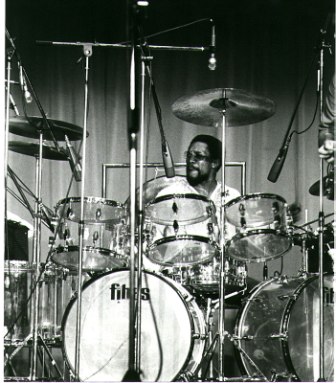 Billy
Cobham
Widely regarded as one of the world’s greatest
living drummers, Cobham’s dazzling skills have seen him perform with the finest
including George Benson, Jack Bruce, Count Basie, Miles Davis and John
McLaughlin. His latest project hooks him up with a band Asere, a band that
epitomise the Cuban street music sounds of 1950s New York, where Billy grew up.
With Asere's raw, gritty groove and Billy's explosive, spectacular playing
style, together they produce dynamite sounds. Billy
Cobham
Widely regarded as one of the world’s greatest
living drummers, Cobham’s dazzling skills have seen him perform with the finest
including George Benson, Jack Bruce, Count Basie, Miles Davis and John
McLaughlin. His latest project hooks him up with a band Asere, a band that
epitomise the Cuban street music sounds of 1950s New York, where Billy grew up.
With Asere's raw, gritty groove and Billy's explosive, spectacular playing
style, together they produce dynamite sounds.
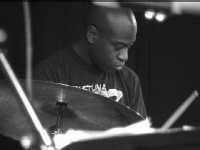  Winston
Clifford is one of Britain's leading jazz drummers. Born September 1965. In
1979 - Studied with ex-Tubby Hayes drummer Bill Eyden. 1985 studied drums with
Trevor Tomkins at Guildhall School of Music. Has played with many musicians
including Courtney Pine, Bheki Mseleku, Jason Rebello, Gary Husband, Pete King,
Dick Heckstall-Smith, Iain Ballamy, Leroy Osbourne, Ronnie Scott Band, Julian
Joseph, Andy Sheppard, Tony Remy, Steve Williamson Band, Jean Toussaint Band,
Slim Gaillard, Bobby Watson, Monty Alexander, Gary Bartz, Art Farmer, Archie
Shepp, Freddie Hubbard etc. Has appeared at many International Festivals &
recorded albums with Frevo, Roadside Picnic, Jean Toussaint, Andy Hamilton,
Brian Dee Trio, Harry Beckett Quintet & Jan Ponsford. Appeared on Channel 4, BBC
2 & ITV as well as radio broadcasts. He has worked with Courtney Pine,
Bheki Mseleku, Jason Rebello, Iain Ballamy, Julian Joseph, Andy Sheppard, Jean
Toussaint, Orphy Robinson, Bobby Watson, Monty Alexander, Birelli Lagrene and
Joey Calderazzo. He has performed in New York and Bombay with Carmen Lundy and
is featured on her latest album, Old Devil Moon. He sings a mean
song all by himself too! Winston
Clifford is one of Britain's leading jazz drummers. Born September 1965. In
1979 - Studied with ex-Tubby Hayes drummer Bill Eyden. 1985 studied drums with
Trevor Tomkins at Guildhall School of Music. Has played with many musicians
including Courtney Pine, Bheki Mseleku, Jason Rebello, Gary Husband, Pete King,
Dick Heckstall-Smith, Iain Ballamy, Leroy Osbourne, Ronnie Scott Band, Julian
Joseph, Andy Sheppard, Tony Remy, Steve Williamson Band, Jean Toussaint Band,
Slim Gaillard, Bobby Watson, Monty Alexander, Gary Bartz, Art Farmer, Archie
Shepp, Freddie Hubbard etc. Has appeared at many International Festivals &
recorded albums with Frevo, Roadside Picnic, Jean Toussaint, Andy Hamilton,
Brian Dee Trio, Harry Beckett Quintet & Jan Ponsford. Appeared on Channel 4, BBC
2 & ITV as well as radio broadcasts. He has worked with Courtney Pine,
Bheki Mseleku, Jason Rebello, Iain Ballamy, Julian Joseph, Andy Sheppard, Jean
Toussaint, Orphy Robinson, Bobby Watson, Monty Alexander, Birelli Lagrene and
Joey Calderazzo. He has performed in New York and Bombay with Carmen Lundy and
is featured on her latest album, Old Devil Moon. He sings a mean
song all by himself too!
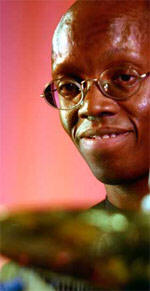 Mark
Mondesir
is self taught and because he could not have a drum set where he
lived he learned to play on pillows and other surfaces at hand, thus Mark’s
style is totally unique, but unlike many self taught players he has a very clear
concept of his meticulous technique and can explain, slow down and demonstrate
the type of playing and concept of time that has baffled drummers for years, but
only after astonishing us by revealing that he plays everything he knows with
just 7 rudiments, surely a comfort for young players daunted by the prospect of
learning endless stickings etc. Mark
Mondesir
is self taught and because he could not have a drum set where he
lived he learned to play on pillows and other surfaces at hand, thus Mark’s
style is totally unique, but unlike many self taught players he has a very clear
concept of his meticulous technique and can explain, slow down and demonstrate
the type of playing and concept of time that has baffled drummers for years, but
only after astonishing us by revealing that he plays everything he knows with
just 7 rudiments, surely a comfort for young players daunted by the prospect of
learning endless stickings etc.
Mark
certainly is one of the most astonishing drummers on this planet with a mind
boggling concept of time, creativity and speed that is bordering the super
human. The late Tony Williams who was notoriously hard to impress was said to
have stood behind the stage curtain when Mark was playing at one of the jazz
festivals, riveted by Mark’s playing. Tony watched the rest of the performance.
After this Tony and Mark became friends.
Dennis Chambers, another good friend of Mark’s, has been singing Mark’s praises
for years on his own video and in print. It is well documented in drum circles
that most top players hold Mark in similar esteem.
Mark began his professional career touring and recording with saxophonist
Courtney Pine. Mark has earnt an enviable reputation as one of the finest
drummers the UK ever produced. Mark has worked with many artist ranging from
rock guitarist Keith More to jazz greats such as: Julian Joseph, John McLaughlin
and Kevin Eubanks.
Marks never ceases to amaze audiences with his awe-inspiring technique, subtle
feel and sheer inventiveness.
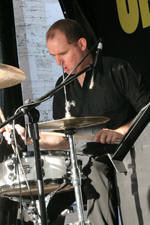 Elliott
Henshaw Elliott
Henshaw
was self-taught until 18 years old at which point he started
studying with Steve Gilbert - an amazing drummer from Manchester - at Salford
University. Whilst at there he began playing in small jazz groups and function
bands, and also for the university big band. It was whilst playing for the
latter that he was asked to join the Andy Prior Orchestra. Whilst still at
college he was touring the UK and playing on various TV/Radio shows with Andy
Prior. At this time he twice won the Radio 2 Big Band drummer of the year award.
ElliottI gained a lot of experience from working with Andy and made lots of
contacts. During this time he was playing in as many difference ensembles as he
could fit in - jazz groups, rock bands, orchestras and musicals etc.
The Quintet band, formed in 2005 and is made up of some of the finest musicians.
Julian Cox,
James Pusey,
Matt Steele,
Simon Willescroft The idea is to play great
melodies and grooves whilst allowing the musicians to stretch out and be
creative. We play a mixture of originals and covers and take our influence from
the likes of Chick Corea, Dave Grusin, Dave Weckl and David Sanborn.
Pete Cater Big Band
Stephen Keogh
Born in Ireland, Stephen
followed his studies there with private lessons in London and New
York. He played as percussionist with the National Symphony
Orchestra of Ireland, contemporary music ensembles and many visiting
jazz artists including Sonny Fortune, Eddie Locklaw Davis, Jimmy
Witherspoon, Pat La Barbera, Louis Stewart, and James Moody. A move
to London in 1988 led to tours and recordings with many British and
American jazz artists including Stan Tracey, Charles McPherson, Art
Farmer, Jason Rebello, Jean Toussaint and Benny Carter. Since moving
to Barcelona in 1990, Stephen has worked all over the world with
many great musicians including Johnny Griffin, Lee Konitz, Phil
Woods, Harrold Land, Peter King Quartet, Brad Mehldau, Mark Turner,
Herb Ellis, Benny Golson and Steve Grossman. He a member of the
European Jazz Piano Trio led by Bill Charlap, Peter King Quartet and
co-leads the Urban Jazz Quintet and Urban Jazz Ensemble.
Chris Dagley 'Drummer' 1972-2010
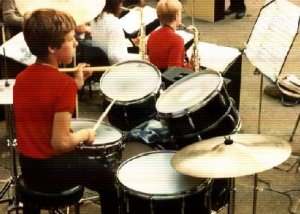 Top
UK session drummer Chris Dagley
(here Aged 12) has performed with NYJO, Jamiroquai, Lalo Schifrin,
Ella Fitzgerald, Eric Clapton, and Chaka Khan Fame Academy and BBC
Big Band. Top
UK session drummer Chris Dagley
(here Aged 12) has performed with NYJO, Jamiroquai, Lalo Schifrin,
Ella Fitzgerald, Eric Clapton, and Chaka Khan Fame Academy and BBC
Big Band.
Comments on one of his drum clinics.
Essentially the clinic was structured around the fundamentals of
being a professional musician. Topics included practicing
efficiently, developing the internal clock, the importance of
different styles, recommended reading and the business side of the
music business, with Chris being remarkably frank about the highs
and lows of being a professional musician. This wasn’t just a
talking clinic however. As Chris was keen to point out, “everything
begins with your ability to consistently perform on your
instrument”. Chris launched into examples from real life pop, heavy
rock and jazz sessions with alarming ease (actual scores were also
provided for the curious to flick through). And at no time did he
seem like a jazz player playing rock or visa versa, playing each
tune with bags of taste and a real mastery of the feels and sounds
associated with each style. As well as playing
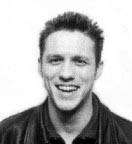 session
tunes, Chris played a series of serious rudimentary exercises at
varied tempos and demonstrated their practical application to the
kit in a musical environment. At one point he performed a
disappearing trick with the click track when demonstrating how to
nail a beat to a metronome. It is obvious to see why he is a player
that is held in such high regard. Rather refreshingly, each playing
example was well considered, and presented on the premise that the
audience wished to learn something as well as be entertained.
However, despite my earlier comments, for me the highlight of the
clinic was Chris’s one opportunity to really let loose on the kit,
playing a funk/fusion track specially written for the clinic by
Richard Cottle. There’s plenty of Gadd and Weckl type licks on show
and every lightning fill landed with uncanny precision on the beat.
This was a well
presented, extremely informative and thoroughly enjoyable clinic.
Personally I would have like to have seen a bit
more of Chris’s playing as it is such a joy to hear such a tasteful
player. I am positive that anybody who was not very familiar with
Chris Dagley’s playing prior to the clinic will be actively seeking
out for his work in the future.
Chris Dagley is one of the most popular drummers
on the jazz and session scenes because of his solid, powerhouse
groove and boundless energy. He also has astonishing solo chops
and is famous for being able to read any piece of music at
sight. session
tunes, Chris played a series of serious rudimentary exercises at
varied tempos and demonstrated their practical application to the
kit in a musical environment. At one point he performed a
disappearing trick with the click track when demonstrating how to
nail a beat to a metronome. It is obvious to see why he is a player
that is held in such high regard. Rather refreshingly, each playing
example was well considered, and presented on the premise that the
audience wished to learn something as well as be entertained.
However, despite my earlier comments, for me the highlight of the
clinic was Chris’s one opportunity to really let loose on the kit,
playing a funk/fusion track specially written for the clinic by
Richard Cottle. There’s plenty of Gadd and Weckl type licks on show
and every lightning fill landed with uncanny precision on the beat.
This was a well
presented, extremely informative and thoroughly enjoyable clinic.
Personally I would have like to have seen a bit
more of Chris’s playing as it is such a joy to hear such a tasteful
player. I am positive that anybody who was not very familiar with
Chris Dagley’s playing prior to the clinic will be actively seeking
out for his work in the future.
Chris Dagley is one of the most popular drummers
on the jazz and session scenes because of his solid, powerhouse
groove and boundless energy. He also has astonishing solo chops
and is famous for being able to read any piece of music at
sight.
 The shocking death
of drummer Chris Dagley
at 38 has robbed British jazz of one of its most respected and best-liked
performers. Bright, friendly and conscientious, he was a crisp, hard-swinging
drummer who took pride in his work and never gave it less than 100 per cent. As
a member of Ronnie Scott’s house band, the James Pearson Trio, he was one of the
busiest musicians in London. He was killed on his way home from the club in the
small hours, when his motorcycle crashed on the A40 dual carriageway near White
City. There were no witnesses. 28/7/10 The shocking death
of drummer Chris Dagley
at 38 has robbed British jazz of one of its most respected and best-liked
performers. Bright, friendly and conscientious, he was a crisp, hard-swinging
drummer who took pride in his work and never gave it less than 100 per cent. As
a member of Ronnie Scott’s house band, the James Pearson Trio, he was one of the
busiest musicians in London. He was killed on his way home from the club in the
small hours, when his motorcycle crashed on the A40 dual carriageway near White
City. There were no witnesses. 28/7/10
He leaves a wife and three young daughters
making this a heartbreaking family tragedy in addition to the considerable loss
to the music.
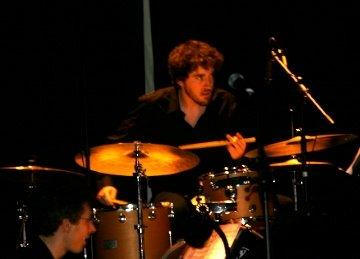 James
Maddren was born and brought up in Christ's
Hospital School in Horsham, Sussex. When 11 he started school at Christ's
Hospital and went on to play in several bands and orchestras. He left CH in
summer 2005 and is currently studying jazz percussion at the Royal Academy of
Music in London. James enjoys listening to and playing all kinds of music. He
has plays with Marc Copland/Stan Sulzmann quartet, Phil Donkin, Gwilym Simcock,
Kit Downes Trio, Martin Speake quartet, Phronesis, Jonathan Bratoeff quartet,
Tangent, Andrea Vicari quintet, Quentin Collins, Claire Martin and many other
musicians and bands across London and the U.K. James
Maddren was born and brought up in Christ's
Hospital School in Horsham, Sussex. When 11 he started school at Christ's
Hospital and went on to play in several bands and orchestras. He left CH in
summer 2005 and is currently studying jazz percussion at the Royal Academy of
Music in London. James enjoys listening to and playing all kinds of music. He
has plays with Marc Copland/Stan Sulzmann quartet, Phil Donkin, Gwilym Simcock,
Kit Downes Trio, Martin Speake quartet, Phronesis, Jonathan Bratoeff quartet,
Tangent, Andrea Vicari quintet, Quentin Collins, Claire Martin and many other
musicians and bands across London and the U.K.
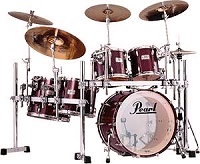 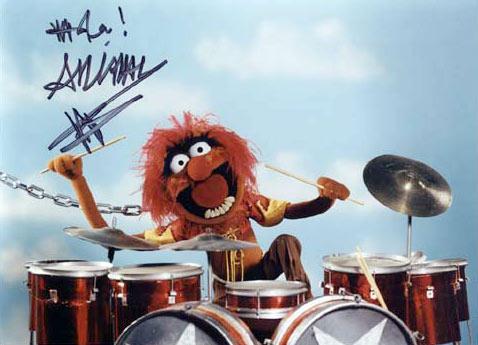
Drum Battle - Animal Versus Buddy Rich
a fierce drum battle with
Buddy Rich, which Animal, of course, won, eventually smashing a snare
drum over Buddy's head.
Then, of course, the battle
at the end with Animal; to play opposite Ronnie Verrell—one of my all-time
favourite drummers, along with Kenny Clare—was a total gas to me.
Buddy Rich
Animal / Verrell with Rita Moreno Singing -
Fever
What Rita says in Spanish
-
"Listen Buddy. All I wanna tell you is that you
shouldn't do that. It's not nice, you
understand? Look at me when I'm talking to you.
This is my number, and if you bother me any more
I'm gonna hit you so hard, it's gonna leave you
stupid. Cool it.
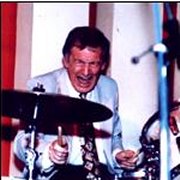
Ronnie
Verrell
Born 21/02/25
Died 11.30am, 22nd Feb 2002
Ronnie has enjoyed a varied career, touring with the famous Ted
Heath Band and working with Jack Parnell's Orchestra on Sunday Night at
the Palladium. He even played drums for Animal in The Muppets
Band.
Ronnie played in the band for the Frank Skinner Show! (UK) for many
years and was a regular session man.
In November 2001, Ronnie fell down the stairs at his home. He crushed a
vertebrae in his neck and hoped to have an operation on February 7th
2002, however when he was given the anaesthetic he had difficulty
breathing and the operation was abandoned. Ronnie died of a chest
infection in hospital at 11.30am 22.02.02. The day before was his 77th
birthday.
Ronnie worked with Ted Heath , Eddie Blair , Laurie
Holloway , Sir Yehudi Menuhin , Bobby Pratt , Ken Kiddier , Johnny
Hawksworth , Max Harris , Duncan Campbell , Lennie Bush , Ken Baldock ,
Don Lusher , John Fraser , Chris Karan , Bob Efford , Martin Taylor ,
Pierre Michelot , Wally Smith, Buddy Rich.
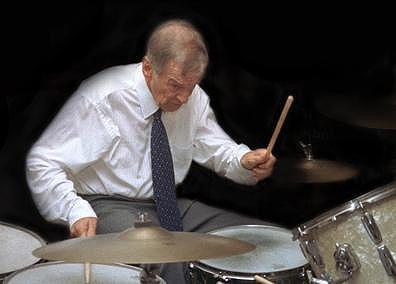 A favoured sticks man with the
Walker Bros was the dapper ‘drummer’s drummer’, Ronnie Verrall. Something of
a legend amongst session circles even then, Verrall would play on many of
the Walker’s group and solo sessions, often stretching out on the floor
between takes to ease his bad back. Like many of the musicians used at
these sessions, Verrall came from a Jazz background, and the techniques of
such an education are used to great effect in the context of these ‘pop’
songs. Verrall’s rolling Tom fills, especially on ‘In
my room’, ‘Archangel’
and
‘People Get Ready’
would add an unexpected edginess to these tracks. The vivid fills sometimes
seem as if they are just about to tumble out of time – they never do.
Players like Verrell are typical of the Jazz influence inherent in the
Walker’s recordings, a flavour that would add another unique ingredient to
an already quixotic mix. A favoured sticks man with the
Walker Bros was the dapper ‘drummer’s drummer’, Ronnie Verrall. Something of
a legend amongst session circles even then, Verrall would play on many of
the Walker’s group and solo sessions, often stretching out on the floor
between takes to ease his bad back. Like many of the musicians used at
these sessions, Verrall came from a Jazz background, and the techniques of
such an education are used to great effect in the context of these ‘pop’
songs. Verrall’s rolling Tom fills, especially on ‘In
my room’, ‘Archangel’
and
‘People Get Ready’
would add an unexpected edginess to these tracks. The vivid fills sometimes
seem as if they are just about to tumble out of time – they never do.
Players like Verrell are typical of the Jazz influence inherent in the
Walker’s recordings, a flavour that would add another unique ingredient to
an already quixotic mix.
 Bill
Bruford Drummer Bill Bruford is
well ahead of this particular field. A founder member of Yes in the 1960s, he
has straddled the divide between rock and jazz in a career which has taken him
from the drum stool in King Crimson and Genesis to leading his own groups -
Bruford from 1977 to 1981, and Earthworks since 1985. The current Earthworks
album, A Part, And Yet Apart, is his most orthodox jazz outing yet, a
spry collection of tunes played by an acoustic quartet comprised of Bruford,
Steve Hamilton (piano), Mark Hodgson (bass) and Patrick Clahar (saxophone). Bill
Bruford Drummer Bill Bruford is
well ahead of this particular field. A founder member of Yes in the 1960s, he
has straddled the divide between rock and jazz in a career which has taken him
from the drum stool in King Crimson and Genesis to leading his own groups -
Bruford from 1977 to 1981, and Earthworks since 1985. The current Earthworks
album, A Part, And Yet Apart, is his most orthodox jazz outing yet, a
spry collection of tunes played by an acoustic quartet comprised of Bruford,
Steve Hamilton (piano), Mark Hodgson (bass) and Patrick Clahar (saxophone).
 Clark
Tracey Clark
Tracey
Clark Tracey was born in London,
in 1961. He grew up in a jazz environment as the son of Stan Tracey,
the UK's leading jazz pianist, and from an early age took to the piano and
vibraphones. At 13 he started playing the drums and gigged until he turned
professional in 1978 by joining his father's various ensembles. In that
context he has toured and recorded extensively.
In 1981 he formed the first of
his own groups with Django Bates, Iain Ballamy and Andrew Cleyndert. Later
groups included Guy Barker, Jamie Talbot, Nigel Hitchcock, Dave O'Higgins,
Mark Nightingale, Mornington Lockett, Julian Arguelles, Gerard Presencer,
Alec Dankworth and Steve Melling. He currently runs a quintet with
luminaries from the new generation (Mark Armstrong, Simon Allen, Zoe Rahman
& Peter Billington) and a trio with Gareth Williams and Arnie Somogyi.
As a composer he has received
commissions for his quintet, an octet shared with pianist Dave Newton,
"Continental Drift" (an 11 piece band co-composed with Stan Tracey
commissioned by The Arts Council), and arrangements for the Berkshire Youth
Jazz Orchestra and the Appleby Festival big band. He has also written string
quartet arrangements for his own group, Claire Martin, Tina May and the folk
group Filska.
As a freelance drummer Clark
has had 25 years' experience playing alongside some of the most important
artists in jazz at home and abroad (see list below), appearing on over 80
albums and touring in around 50 countries. He has been awarded "Best Drums"
title three times in the British jazz awards and received endorsements from
Zildjian Cymbals in 1998 and Vic Firth Sticks and Remo Drumheads in 1999.
Clark also teaches privately
and at school and has given masterclasses at Leeds College of Music, Royal
Academy of Music, Musicians' Institute, Bracknell jazz weekends and
festivals as well as overseas workshops.
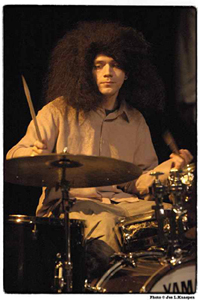 Sebastian Rochford,
Aberdonian whose massive hair looks as if someone has plugged him into the mains, has a
musical background that explains much of the group Polar Bear's eclectic sound.
"I first started playing drums along to Prince and Grace Jones records," he
says. "Then I got into Iron Maiden, Metallica and John Bonham of Led Zeppelin."
Only later did he discover jazz, and subsequently shared a teacher with
orchestral percussionist Evelyn Glennie. "A lot of heavy metal drumming is
highly technical and fast," he says. "But what I love is music that doesn't
compromise, whether that's Tom Jobim or Pig Destroyer." Roachford has
little time for jazz purists: "From the start jazz was a mixture of musics - New
Orleans was a giant melting pot. I tend to like bands who are vague as to what
their genre is." Plenty of critics have felt this new wave of jazz so
distinctive that it ought to have its own label, (candidates include post-jazz
and "skronk"), but Roachford is wary of pigeonholing. "I admire artists like
Radiohead or Miles Davies, who have made very different records. In the end it's
just their music, which they have stamped their identity on, and which people
tell each other about. There's a precious freedom to manoeuvre that we'd hate to
lose." Sebastian Rochford,
Aberdonian whose massive hair looks as if someone has plugged him into the mains, has a
musical background that explains much of the group Polar Bear's eclectic sound.
"I first started playing drums along to Prince and Grace Jones records," he
says. "Then I got into Iron Maiden, Metallica and John Bonham of Led Zeppelin."
Only later did he discover jazz, and subsequently shared a teacher with
orchestral percussionist Evelyn Glennie. "A lot of heavy metal drumming is
highly technical and fast," he says. "But what I love is music that doesn't
compromise, whether that's Tom Jobim or Pig Destroyer." Roachford has
little time for jazz purists: "From the start jazz was a mixture of musics - New
Orleans was a giant melting pot. I tend to like bands who are vague as to what
their genre is." Plenty of critics have felt this new wave of jazz so
distinctive that it ought to have its own label, (candidates include post-jazz
and "skronk"), but Roachford is wary of pigeonholing. "I admire artists like
Radiohead or Miles Davies, who have made very different records. In the end it's
just their music, which they have stamped their identity on, and which people
tell each other about. There's a precious freedom to manoeuvre that we'd hate to
lose."
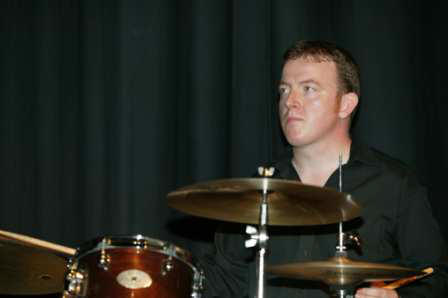 Mike
Smith started playing Drums at the age of 9. He joined a Youth Big Band
in the Oxford area when he was around 11 (which was co run by his father).
At 13 he started attending rehearsals for the National Youth Jazz Orchestra
and at the age of 15 became the regular drummer. He stayed with the
Orchestra for 5 years, during that time he worked with many great soloists
and singers from the UK and the USA, namely, John Dankworth,, Cleo Lane,
John Williams (the guitarist), Shorty Rogers to name but a few. Mike
Smith started playing Drums at the age of 9. He joined a Youth Big Band
in the Oxford area when he was around 11 (which was co run by his father).
At 13 he started attending rehearsals for the National Youth Jazz Orchestra
and at the age of 15 became the regular drummer. He stayed with the
Orchestra for 5 years, during that time he worked with many great soloists
and singers from the UK and the USA, namely, John Dankworth,, Cleo Lane,
John Williams (the guitarist), Shorty Rogers to name but a few.
In 1987 Mike Joined the BBC
Big Band and BBC Radio Orchestra. He was with the BBC up until 1997 and
during that time he had the great honour of working with some world class
composers/arrangers, soloists and singers; most notably, Robert Farnon,
Angela Morley, Ronnie Hazlehurst, George Shearing, Georgie Fame, Madeline
Bell, Bobby Shew and many others
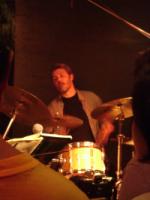 Keith
Michael Keith - before
leaving UK in 1981, played jazz in and around London with a number
of players, including Lol Coxhill, Simon Picard and Veryan Weston. based
in Amsterdam, spent several years involved in theatre, modern dance and
mixed media performance groups & projects. Touring in Europe and
Australia. Moved to Asia in '87; in India played with several groups /
projects, incl. "East-West", w/Sarod master Usmahn Kahn. Zen Samba, w/Alryio
Lima (Weather Report): in Thailand, Korea and Japan, playing with
numerous players incl. Randy Cannon, Dave Sills, Dan Phillips, Ed Jones,
Damon Brown, Toku, Aoyagi Makoto, Yosuke Onuma, Shinji Nakamura, Paul
Jackson, Harvey Thompson, Kuwana Masahiro, Kojima Yoshinobu. Baba
Takayoshi, Philip Strange. Keith has returned to the UK shres for a
spell. Keith
Michael Keith - before
leaving UK in 1981, played jazz in and around London with a number
of players, including Lol Coxhill, Simon Picard and Veryan Weston. based
in Amsterdam, spent several years involved in theatre, modern dance and
mixed media performance groups & projects. Touring in Europe and
Australia. Moved to Asia in '87; in India played with several groups /
projects, incl. "East-West", w/Sarod master Usmahn Kahn. Zen Samba, w/Alryio
Lima (Weather Report): in Thailand, Korea and Japan, playing with
numerous players incl. Randy Cannon, Dave Sills, Dan Phillips, Ed Jones,
Damon Brown, Toku, Aoyagi Makoto, Yosuke Onuma, Shinji Nakamura, Paul
Jackson, Harvey Thompson, Kuwana Masahiro, Kojima Yoshinobu. Baba
Takayoshi, Philip Strange. Keith has returned to the UK shres for a
spell.
Catch Keith at the Space Below on Wednesdays in Soho.
Graeme Culham
Drums
on the Web
 The Chiltern
Hundreds Jazz
Festival - yes it is possible - given Arts Grants and Corporate support.
There are sufficient venues both in the Town Centres and the surrounding Villages
to create a Major Annual Event (even Bicester can organise one) - If you are
interested then declare here in what capacity you are prepared to assist.
The Chiltern Hundreds Jazz Festival Support The Chiltern
Hundreds Jazz
Festival - yes it is possible - given Arts Grants and Corporate support.
There are sufficient venues both in the Town Centres and the surrounding Villages
to create a Major Annual Event (even Bicester can organise one) - If you are
interested then declare here in what capacity you are prepared to assist.
The Chiltern Hundreds Jazz Festival Support
|